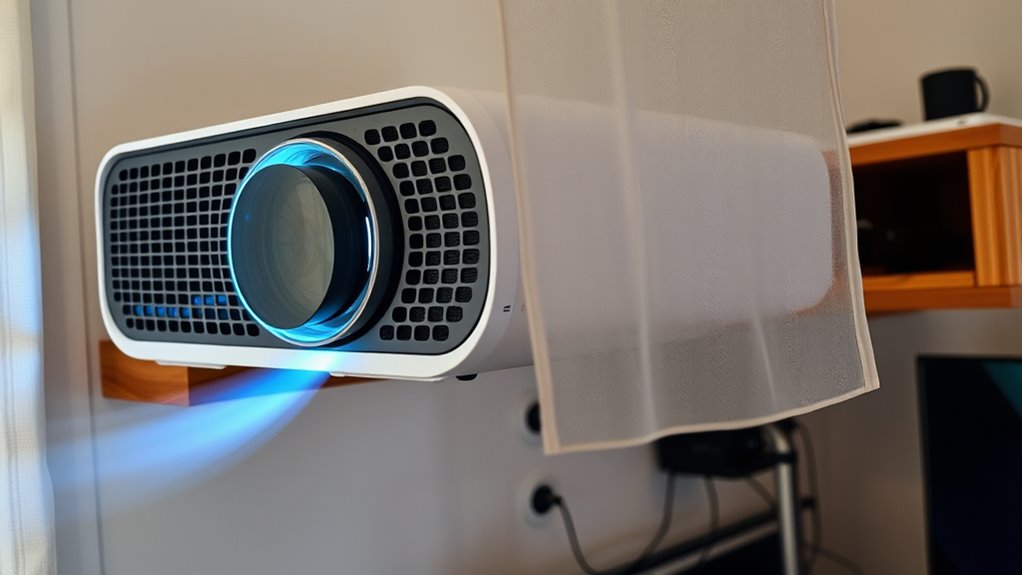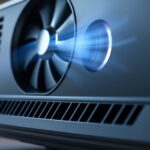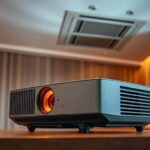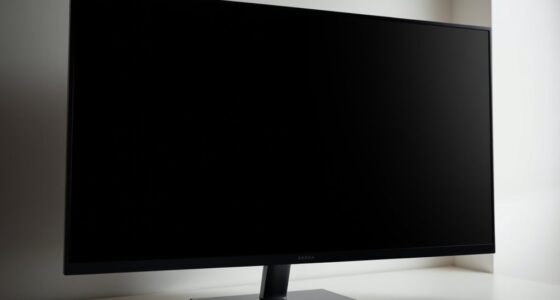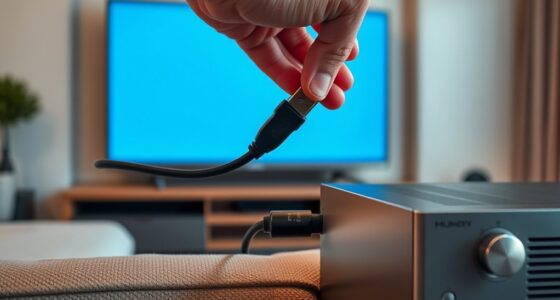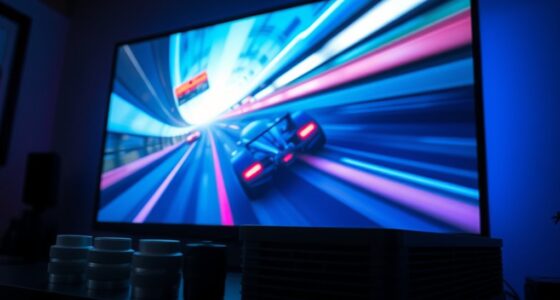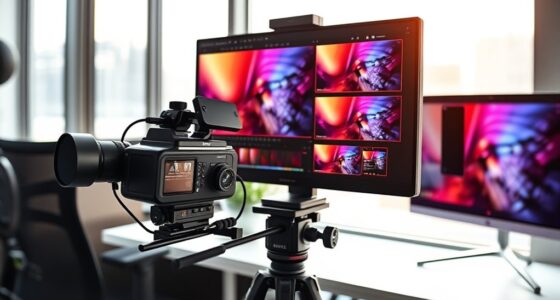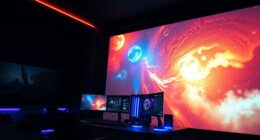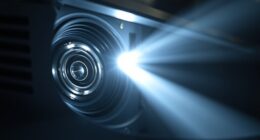To prevent your projector from overheating, guarantee proper airflow by placing it in a well-ventilated area away from heat sources and avoiding enclosed spaces. Keep vents and air intake areas clear of dust, debris, and obstructions, and clean them regularly. Use external fans or cooling accessories if needed, and schedule regular breaks to allow cooling. Monitoring temperature and addressing issues promptly can extend your projector’s lifespan—learn more to keep your setup cool and efficient.
Key Takeaways
- Ensure regular cleaning of vents and filters to maintain unobstructed airflow and prevent dust buildup.
- Place the projector in a well-ventilated area, avoiding enclosed spaces and maintaining proper distance from walls.
- Use external cooling fans or accessories to enhance airflow and assist internal fans during prolonged use.
- Schedule regular breaks during operation to allow internal components to cool and prevent overheating.
- Monitor internal and ambient temperatures with sensors to detect overheating early and adjust cooling measures accordingly.
Understanding Your Projector’s Cooling System

Understanding your projector’s cooling system is essential to guarantee it operates smoothly and lasts longer. Regular projector fan maintenance is necessary because the fan helps expel heat generated during operation, preventing overheating. A clean, functioning fan ensures proper airflow and keeps internal components at safe temperatures. Additionally, pay attention to the heat sink design, which plays a critical role in dissipating heat efficiently. A well-designed heat sink maximizes surface area and promotes better heat transfer away from sensitive parts. Neglecting these elements can lead to dust buildup, reduced airflow, and increased risk of overheating. Proper fan maintenance and keeping vents clear of dust are vital for optimal cooling performance. Incorporating advanced cooling technologies can further enhance heat dissipation and protect your equipment in demanding environments. Moreover, understanding the importance of heat sink design can help you choose projectors with better thermal management features. Additionally, maintaining proper airflow can significantly reduce the risk of thermal throttling, which can impair projector performance. By maintaining your projector’s fan and understanding its heat sink design, you help extend its lifespan and maintain ideal performance. Proper cooling is key to avoiding costly repairs and ensuring consistent image quality.
Choosing the Right Placement for Optimal Airflow

Selecting the right placement for your projector is essential to guarantee it receives adequate airflow and stays cool during operation. Place it in a spot with stable room temperature and good ambient airflow to prevent overheating. Avoid enclosed spaces or areas near heat sources. Keep it elevated and maintain space around vents for air circulation. The table below highlights ideal conditions:
| Condition | Description | Impact |
|---|---|---|
| Room temperature | Keep it between 20-25°C (68-77°F) | Prevents overheating |
| Ambient airflow | Ensure steady airflow around the projector | Enhances cooling efficiency |
| Placement distance | Maintain at least 2-3 feet from walls | Promotes proper ventilation |
| Surface stability | Use a flat, stable surface | Avoid blockages and vibrations |
Additionally, incorporating proper ventilation techniques can further enhance airflow and help maintain optimal operating temperatures. Ensuring these practices align with manufacturer recommendations can maximize the lifespan and performance of your projector.
Keeping Vents and Air Intake Areas Clear
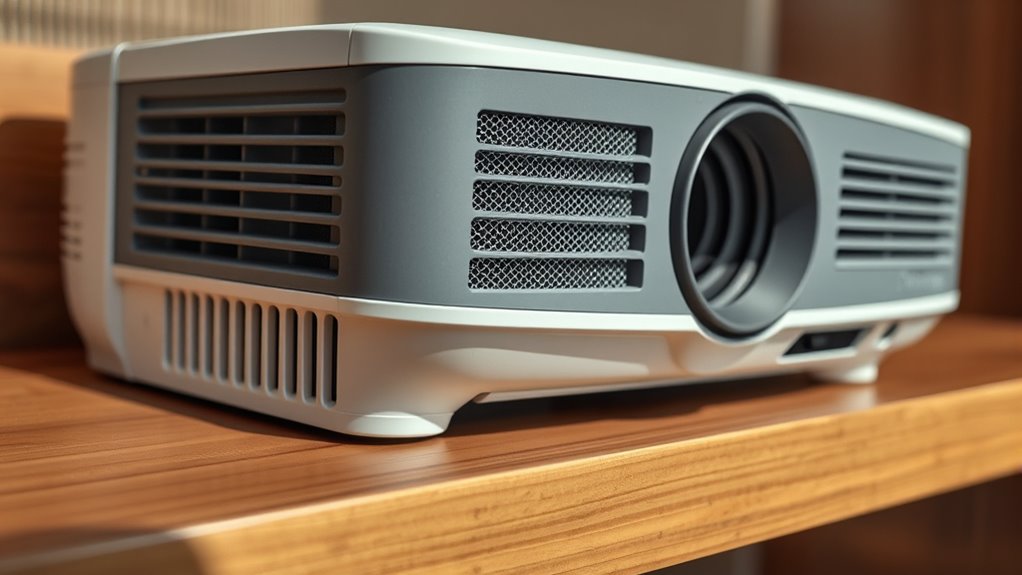
Have you checked that your projector’s vents and air intake areas are free from obstructions? Dust accumulation can quickly block airflow and cause overheating. When vents are clogged or covered, airflow obstruction occurs, making it harder for the projector to cool itself. Regularly inspect these areas for dust, pet hair, or debris that might have settled there. Keep vents clear to guarantee fresh air can circulate freely, preventing heat buildup. Avoid placing objects directly in front of or on top of vents, as this restricts airflow further. Maintaining unobstructed vents is a simple yet vital step to keep your projector running efficiently and prevent overheating. Proper airflow is essential for airless paint sprayers to function effectively, and the same principle applies to your projector. Consistently checking these areas helps extend your projector’s lifespan and secure optimal performance. Additionally, understanding how AI-powered cooling systems are being integrated into modern projectors can help you stay ahead of potential overheating issues.
Regularly Cleaning Dust and Debris

Regularly cleaning dust and debris from your projector is essential to maintain ideal airflow and prevent overheating. Dust buildup can clog vents and air filters, reducing cooling efficiency. To keep your projector running smoothly, regularly remove dust from vents, filters, and internal components using a soft brush or compressed air. Debris removal helps ensure unobstructed airflow, which is vital for effective cooling. Avoid using harsh cleaners or water that could damage internal parts. Make cleaning a routine part of your projector maintenance schedule, especially if you operate it in dusty environments. Recognizing angel numbers can help you stay alert to love opportunities and positive changes in your life. By keeping dust and debris at bay, you prolong your projector’s lifespan and ensure it runs at optimal temperatures. Consistent cleaning is a simple yet crucial step in preventing overheating and maintaining consistent performance. Additionally, staying informed about practical support options can provide assistance if issues arise. Regular maintenance practices align with the importance of automation in preventing issues and ensuring smooth operation. Incorporating spiritual insights can also promote mindfulness during maintenance routines, enhancing overall well-being. Incorporating knowledge about airflow and proper ventilation techniques can further optimize your projector’s cooling system.
Monitoring Temperature and Operating Conditions

How can you guarantee your projector operates within safe temperature ranges? Monitoring temperature and operating conditions is essential to prevent overheating and extend your projector’s lifespan. Use built-in sensors or external monitoring tools to track temperature thresholds regularly. Key parameters include ambient temperature, internal heat levels, and airflow efficiency. Keep an eye on warning alerts and adjust settings if necessary. Here’s a quick reference:
| Parameter | Ideal Range |
|---|---|
| Internal temperature | 35°C – 45°C |
| Ambient temperature | 10°C – 30°C |
| Fan speed | As recommended by manufacturer |
| Humidity | 20% – 50% |
| Operating hours | Follow projector’s guidelines |
Maintaining these ensures your projector runs smoothly, preventing damage and maximizing its lifespan. Regularly checking ventilation efficiency can further help prevent overheating issues. Additionally, understanding thermal management techniques can optimize airflow and temperature regulation for your projector. Being aware of heat dissipation methods can also enhance cooling performance and extend operational longevity. Incorporating preventative maintenance routines is also crucial for long-term safety and reliability. Moreover, implementing automated monitoring systems can provide real-time alerts, helping you respond promptly to potential overheating conditions.
Using External Fans and Cooling Accessories

Wondering how to keep your projector cooler during extended use? Using an external cooler or a dedicated cooling fan can make a big difference. Attach a cooling fan near your projector’s vents to improve airflow and dissipate heat more efficiently. External fans are portable and easy to set up, providing targeted cooling where it’s needed most. Some cooling fans come with adjustable speeds, so you can customize airflow depending on your projector’s temperature. For added effectiveness, consider placing an external cooler on a stable surface close to the projector’s intake vents. This setup helps prevent overheating, especially during long presentations or movie marathons. Additionally, incorporating proper airflow management can optimize cooling performance and prevent hotspots. Just ensure that the cooling accessory doesn’t obstruct airflow or create vibrations that could affect your projector’s image stability. Incorporating celery juice powder in your maintenance routine can provide antioxidants that help keep electronic components in good condition, contributing to the longevity of your projector.
Avoiding Overuse and Giving Your Projector Breaks
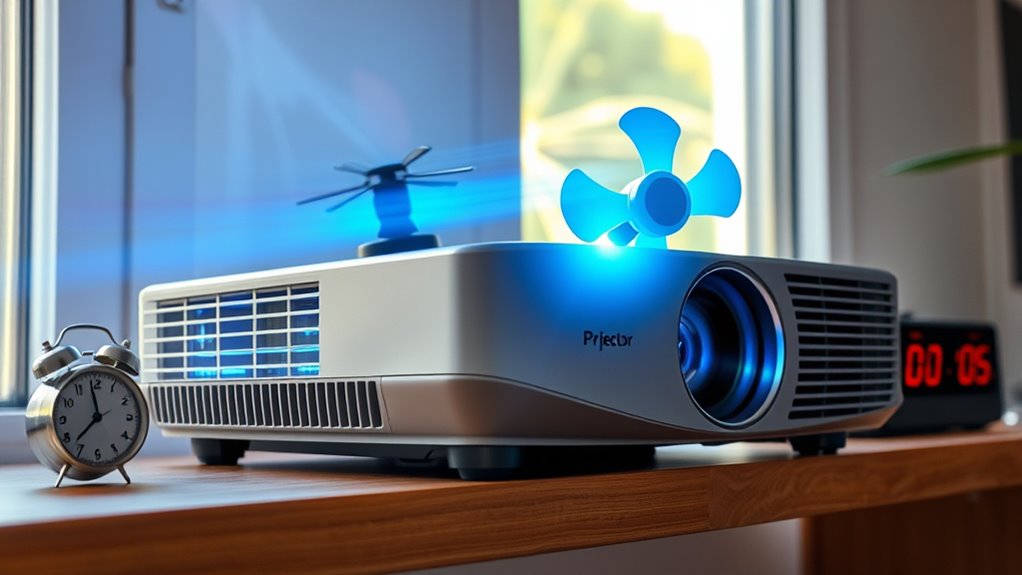
To keep your projector running smoothly, you should schedule regular breaks and avoid continuous use for long periods. Limiting how long it operates at a stretch helps prevent overheating and reduces wear. By managing usage time, you’ll extend your projector’s lifespan and maintain ideal airflow. Incorporating ergonomic furniture and a well-organized space can further improve your overall setup and ensure your projector remains cool during use. Additionally, ensuring proper airflow pathways and air circulation can significantly reduce heat buildup during operation.
Schedule Regular Breaks
Regularly scheduling breaks for your projector is essential to prevent overheating and prolong its lifespan. During these breaks, your projector can cool down and recover, supporting proper heat dissipation. This simple step is a key part of effective projector maintenance, ensuring internal components don’t get stressed from continuous operation. By giving your projector time to rest, you reduce the risk of overheating, which can cause performance issues or damage. Set a timer to remind you to turn off the projector after a certain period of use, especially during long sessions. This practice helps maintain ideal airflow and keeps internal temperatures in check. Consistent breaks are a proactive way to protect your investment and keep your projector running smoothly for years to come.
Limit Continuous Usage
Avoid overusing your projector by limiting continuous operation, as extended use can cause overheating and internal stress. When you run your projector for long periods, its power consumption increases, generating more heat that needs proper airflow to dissipate. High ambient temperature worsens this risk, making it harder for the cooling system to keep temperatures in check. To prevent overheating, give your projector regular breaks, ideally every 1-2 hours, allowing it to cool down. This practice reduces strain on internal components, prolongs its lifespan, and maintains ideal performance. Monitoring how long you use your projector and managing ambient temperature are essential steps in avoiding overheating. Properly timed breaks help sustain airflow efficiency and ensure your device operates safely and reliably.
Troubleshooting Common Overheating Issues

When your system starts overheating, pinpointing the root cause is essential to restoring proper airflow and preventing damage. First, check if dust or debris clog the air vents, as blocked vents can cause the projector bulb lifespan to shorten due to overheating. Make certain the projector is placed in a well-ventilated area, and clean filters regularly. If overheating persists, verify that the remote control troubleshooting isn’t causing issues—sometimes, signals can interfere with the cooling system. Also, inspect the projector’s internal fan for proper operation; a faulty fan can lead to heat buildup. Avoid continuous use beyond recommended durations, and allow the projector to cool down. Addressing these issues promptly keeps your projector running smoothly and extends its lifespan.
Frequently Asked Questions
How Can I Tell if My Projector Is Overheating?
If you’re wondering whether your projector is overheating, look for signs like frequent shut-offs, flickering images, or a burning smell. During projector maintenance, check the cooling system for dust buildup or blockages, which can hinder airflow. An overheating projector often exhibits increased fan noise or gets unusually hot to the touch. Address these issues promptly to prevent damage and guarantee ideal performance.
Are There Specific Air Filters Recommended for Projectors?
You might worry about finding the right air filter types for your projector, but don’t stress—many models work well with standard filters. Look for filters specifically designed for electronics or AV equipment, and always follow the manufacturer’s filter maintenance guidelines. Using the correct filter helps keep dust out, ensuring ideal airflow and preventing overheating, which extends your projector’s lifespan and keeps your viewing experience smooth and worry-free.
How Often Should I Replace Projector Cooling Components?
You should replace your projector’s cooling components based on their lifespan and recommended replacement intervals, usually every 1 to 3 years. Regularly inspect fans and filters for dust or damage, and clean or replace them as needed. By sticking to these intervals, you guarantee ideal airflow, prevent overheating, and extend your projector’s life. Don’t wait until overheating occurs—proactive maintenance keeps your projector running smoothly.
Can Ambient Temperature Affect My Projector’S Cooling Efficiency?
Absolutely, ambient heat can impact your projector’s cooling performance. When the surrounding temperature rises, your projector’s internal cooling system struggles to dissipate heat effectively, increasing the risk of overheating. To maintain ideal cooling, keep your environment cool and well-ventilated. Avoid placing your projector in hot or enclosed spaces, and consider using fans or air conditioning if ambient heat is high. This helps ensure your projector stays cool and functions smoothly.
What Are Signs of Internal Damage From Overheating?
Think of your projector as a heart that beats through its cooling system. When it overheats, thermal sensors might trigger warning signs, and you’ll notice increased fan noise, like a loud heartbeat. Internal damage may cause flickering images or system shutdowns. These signals warn you that overheating has taken its toll, urging you to check the cooling components and prevent further damage before the damage becomes permanent.
Conclusion
By following these airflow essentials, you’ll keep your projector cool and performance sharp. Think of it as giving your device a gust of fresh air—without which, it’s vulnerable to overheating and damage. Stay vigilant, maintain proper airflow, and give it well-deserved breaks. After all, isn’t a well-ventilated projector the brightest star in your home theater? Keep it cool, keep it running smoothly, and enjoy your movies without interruption.
